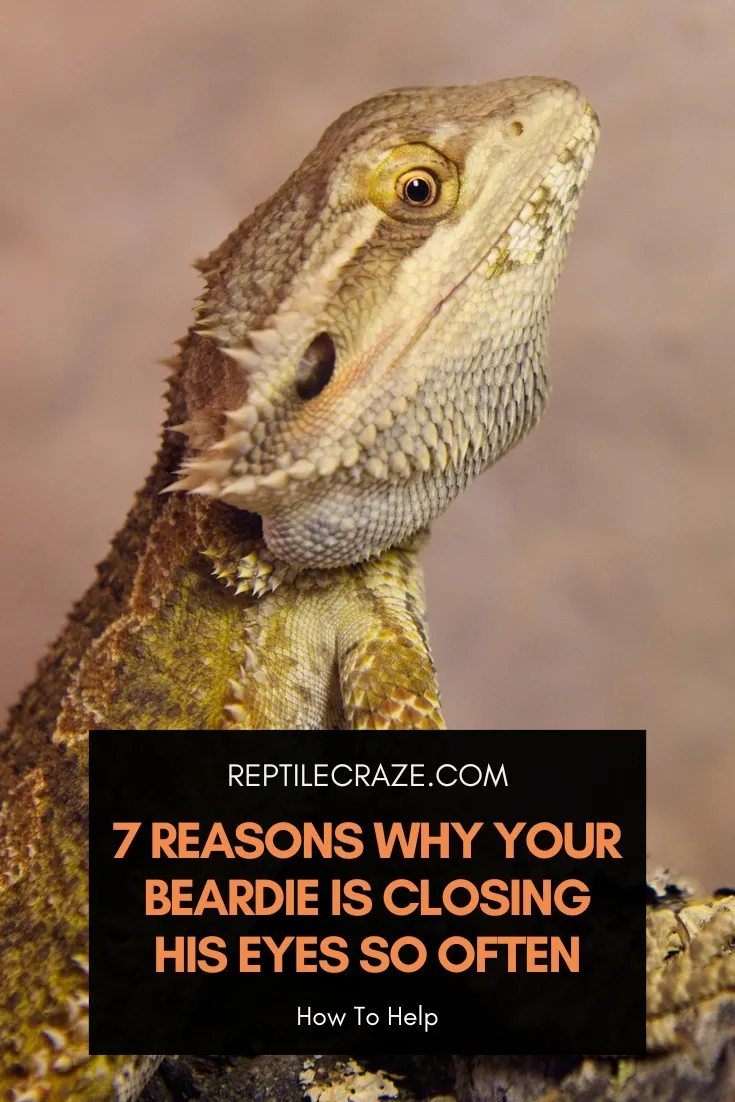
In the wild, bearded dragons are often on the lookout for predators. Due to this reason, they are naturally adapted to keeping their eyes open most of the time. So, if your beardie is closing its eyes frequently, there’s a cause for concern.
A bearded dragon may close its eyes when it’s being petted or held. This shows that it’s feeling stressed or uncomfortable. Some other medical reasons include dehydration, shedding, eye infections, and parasitic infections.
If you want to know more about why your beardie is closing its eyes, we’ve covered the most common reasons in this article. So, read on!
Table of Contents
7 Reasons Why Bearded Dragons Keep Their Eyes Closed
From general discomfort to actual medical issues, there are numerous reasons for a bearded dragon to close its eyes. Let’s understand each in detail.
1. Discomfort While Petting or Holding Bearded Dragon
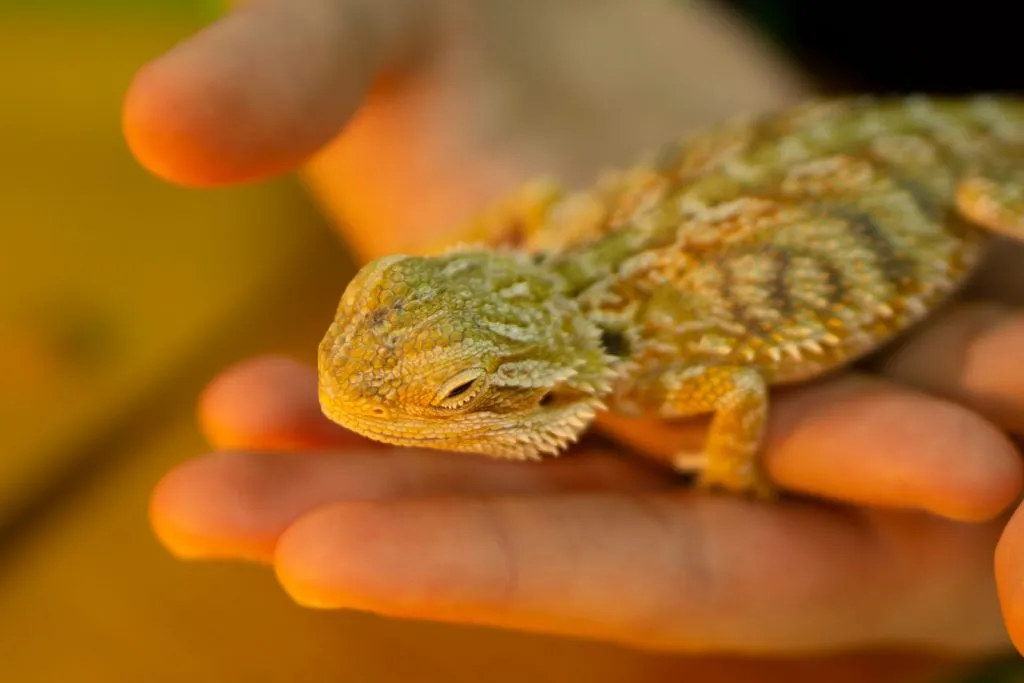
Although bearded dragons aren’t as expressive as other pets, they have their own unique quirks and habits.
For instance, unlike dogs and cats who close their eyes out of relaxation, these little reptiles close them when they’re feeling uncomfortable.
So, a general misunderstanding among new bearded dragon owners is that they misinterpret discomfort as relaxation! Now, this situation is extremely common when you’re petting or holding your little pet beardie.
Most bearded dragons don’t enjoy being petted or held – they just tolerate it. However, some of them may even express genuine unwillingness or dislike towards it by closing their eyes. The same situation is observed in baby bearded dragons too.
Now, there are several reasons why a beardie won’t tolerate being petted or held. We have listed a few common ones below.
- Anxiety or stress due to improper
tank conditions, poor diet, or illness. - General temperament and personality
- Improper handling
- Trauma due to past owners (common in adopted beardies)
Other Signs of Discomfort
Along with closing eyes, some other signs of discomfort include:
- Sounds of hissing
- Open mouth
- Puffed up beard
- Bobbing head
- Stress marks
How to Fix It?
You can find the root cause of the issue and fix it. But if your bearded dragon simply doesn’t like being touched, there’s not much you can do. In such cases, it is best to just let them be!
2. Dehydration
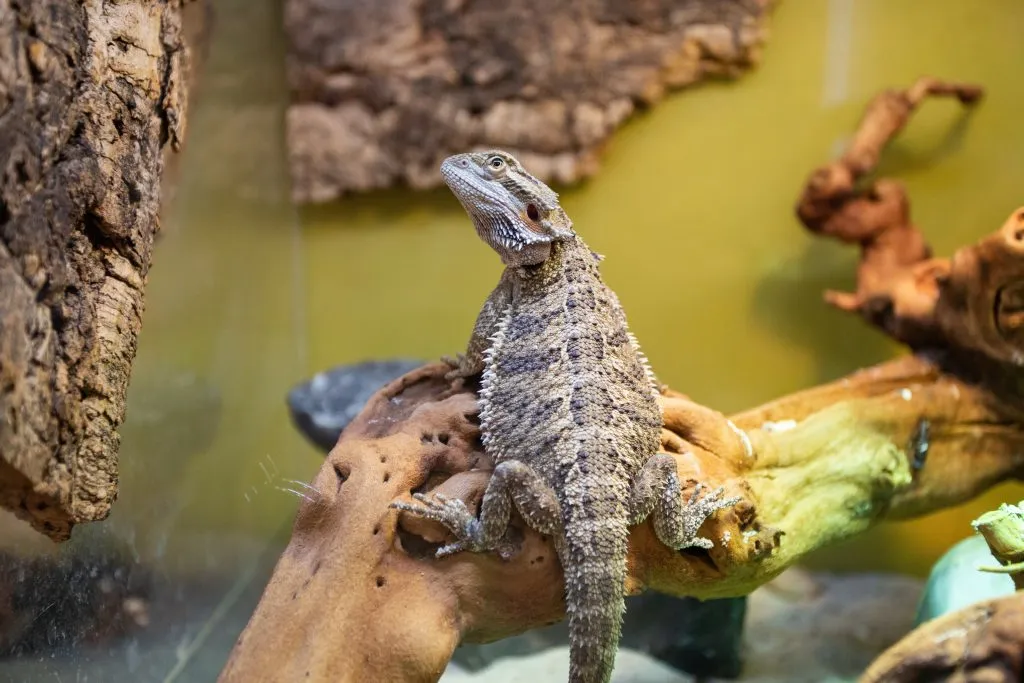
Humans aren’t the only species that need to stay hydrated. If your bearded dragon isn’t well-hydrated, it is going to show on its body too. One major sign of dehydration is when your beardie closes its eyes or has “sunken eyes”.
According to ScienceDirect, the water intake for most reptiles is around 0.7% to 2.7% of body mass per day. If they don’t get the required amount of water, they may close their eyes for moisture preservation.
If you’re wondering why your bearded dragon got dehydrated suddenly, look out for these causes.
- Feeding an improper diet
- Illnesses and parasitic infections
- Feeding citrus fruits like lemon and orange (due to high fiber and high sugar)
- Not providing a clean water bowl
Other Signs of Dehydration
To ensure that your bearded dragon is dehydrated, look for some other signs as listed below.
- Lethargy
- Constipation
- Dry and wrinkly skin
- Shedding problems
- Reduced appetite
How to Fix It?
If the dehydration isn’t too serious, you can try out various solutions to rehydrate your beardie.
- Keep a clean and shallow water dish in the enclosure.
- Provide moisture-rich foods (Veggies are great!) along with a protein-filled diet.
- Frequent misting and bathing
Tip: If this doesn’t help, you need to take your bearded dragon to a vet immediately. If there is no reptile vet in your area, we highly recommend booking an online vet. You can book an online vet at Vetster, for example. They offer fantastic, affordable service and appointments 24/7.
3. Eye Infection
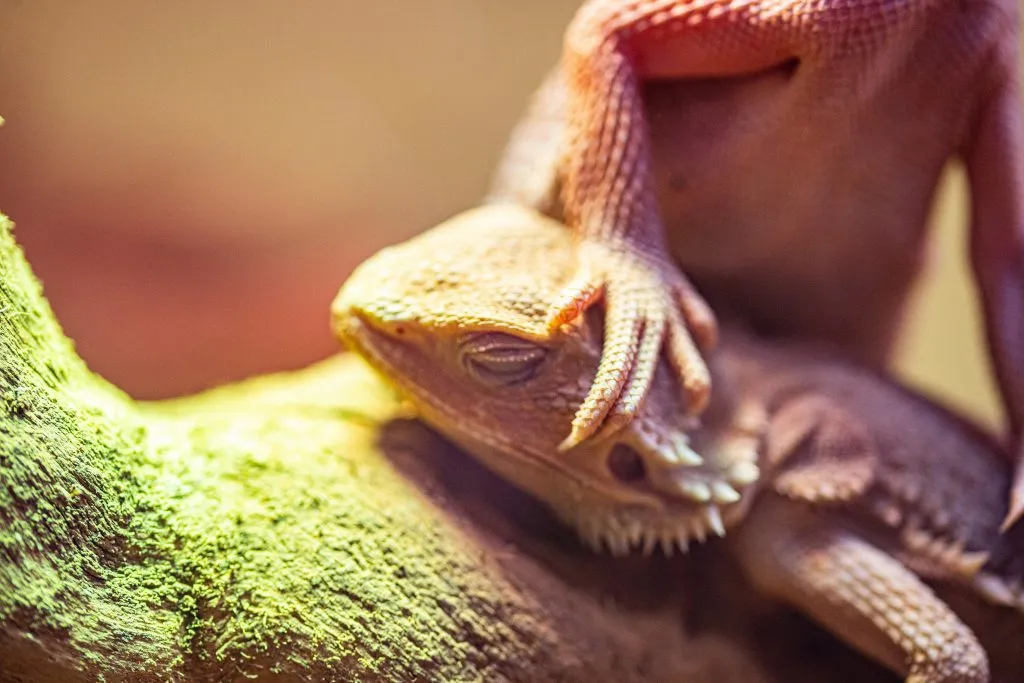
Eye infections are pretty common in bearded dragons. Hence, your beardie might close its eyes to reduce the pain or protect the damaged or inflamed tissues.
Keep in mind that eye infections are mainly caused due to dietary or hygiene reasons.
Bearded dragons need vitamins and minerals in their diet. A lack of vitamins, especially Vitamin A (hypovitaminosis A), may cause eye infections.
Additionally, poor
Other Signs of Eye Infection
If you suspect that your beardie has an eye infection, you might notice these signs too.
- Crust-like layer around eyes
- Swollen eyes
- Discharge from eyes
- Red or black spots around the eyes
How to Fix It?
You should take your bearded dragon to a vet in case of an eye infection. A vet might recommend the below-mentioned solutions depending on the severity.
- Incorporating Vitamin-A-rich foods and supplements in your pet’s diet.
- Giving a warm bath to soothe the inflammation.
- Using reptile eye drops (as prescribed by the vet)
4. Lighting Issues
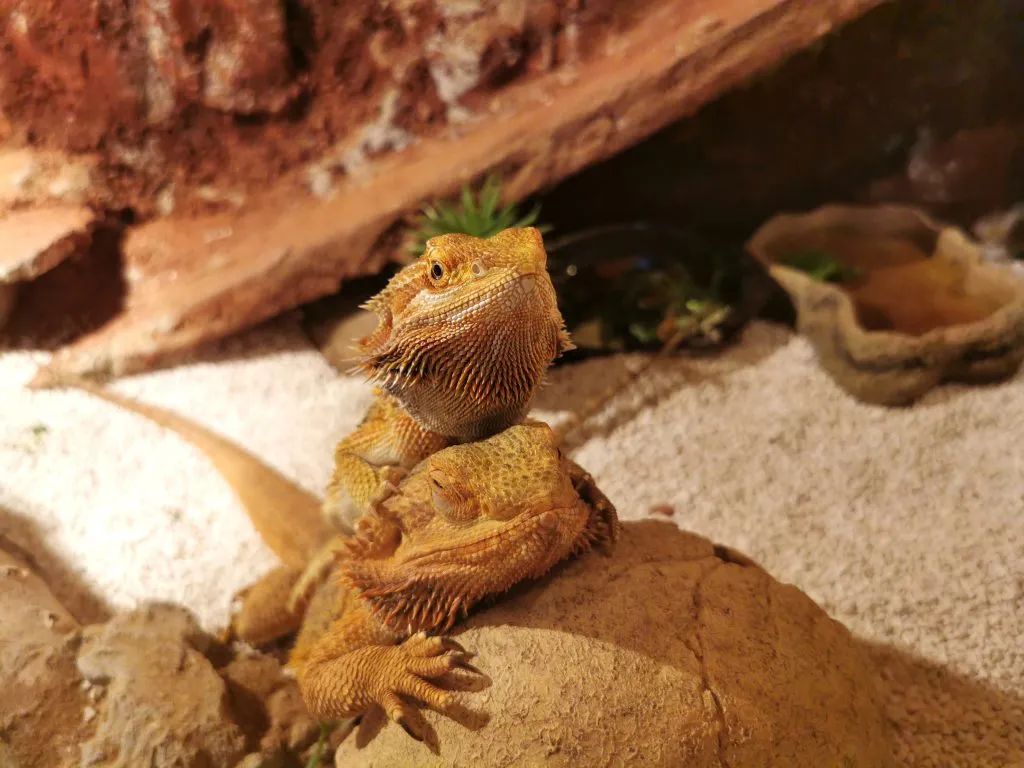
We all close our eyes when a stark bright light is thrown on our faces. Well, lighting issues can also cause your bearded dragon to keep its eyes shut.
Typically, bearded dragons need at least 12 to 14 hours of UVB lighting. However, the UVB bulb should be able to emit 8% to 10% UVB. If it’s less than that, there might be problems with calcium absorption.
On the other hand, overexposing your beardie to too much UVB can also lead to issues. For instance, your bearded dragon may keep its eyes shut. It may also cause problems related to excessive calcium absorption (hypercalcemia).
Common reasons for lighting or UVB issues are listed below.
- The bulb is located too close to your beardie
- The bulb is kept on for an extended period
- No hides in the enclosure
- Low-quality bulb
Other Signs of Lighting Issues
If you suspect UVB-related issues, look out for these other signs.
- Lethargy
- Sluggish movements
- Swollen eyes
- Cloudy layer around eyes
- Glass surfing
- Thickened or darkened skin
How to Fix It?
You can fix UVB-related issues by purchasing a good-quality lamp, placing it properly, and providing sufficient hides. Also, turn on the bulb only during day time.
Tip: We show you the best UVB bulbs for bearded dragons and answer related questions in this article.
5. Stuck Shed
Most times if you’re offering proper
So, if your bearded dragon is not opening its eyes during or after shedding, check for any stuck shed. The shed skin may prohibit its eyes’ mobility, and cause immense pain.
Always bear in mind that a stuck shed is caused due to:
- Low humidity
- Poor diet
- Vitamin A deficiency
- Improper heat and lighting
- Skin or parasitic infections
Other Signs of Shedding Problems
Apart from the eye area, you may find a stuck shed near the head, belly, tail, and toes. This type of skin looks pale, old, and milky compared to fresh skin.
How to Fix It?
If you see a stuck shed on your beardie’s body, don’t pull it. This might cause more pain to your pet. Instead, consider giving it a warm bath. Once you have done that, you can use a cotton swab or toothbrush to gently massage the shed skin.
You can avoid future stuck shed issues by providing a relative humidity between 35% and 40% .
6. Parasitic Infection
Parasitic infections can affect various body parts of your bearded dragon, including the eyes. The reason is simple – most parasites, like mites, attack soft tissues. Hence, they might affect the eye tissues and the surrounding areas.
Parasitic infection can cause the eyes to swell and even tear up. Consequently, it may appear as if your beardie has closed its eyes. Or, it may actually close it out of pain and distress.
The cause of parasitic infections is mainly hygiene-related. Dirty enclosures or purchasing parasite-infested supplies may lead to parasitic infections in bearded dragons.
Other Signs of Parasitic Infection
Some other signs of parasitic infections are listed below.
- Presence of red or brown spots near eyes or ears
- Weight loss
- Abnormal stools
- Lethargy
- Irritability
- Loss of appetite
How to Fix It?
In the case of parasitic infections, you should take your pet to a veterinarian. You can also give them a warm water bath, along with Betadine, to help with the infection.
7. Basking
It can get confusing to gauge whether your beardie is closing its eyes while basking due to lighting issues. After all, they may close their eyes or at least close them partially for relaxation during the basking process.
You can figure out the difference by noticing your beardie. If you notice any general discomfort or swelling near the eyes, it might be because of the basking light.
On the contrary, if your beardie is comfortable, it might just sit there with its mouth open and eyes closed (sometimes). So, you don’t need to do anything in this situation!
Why Do Bearded Dragons Close One Eye?
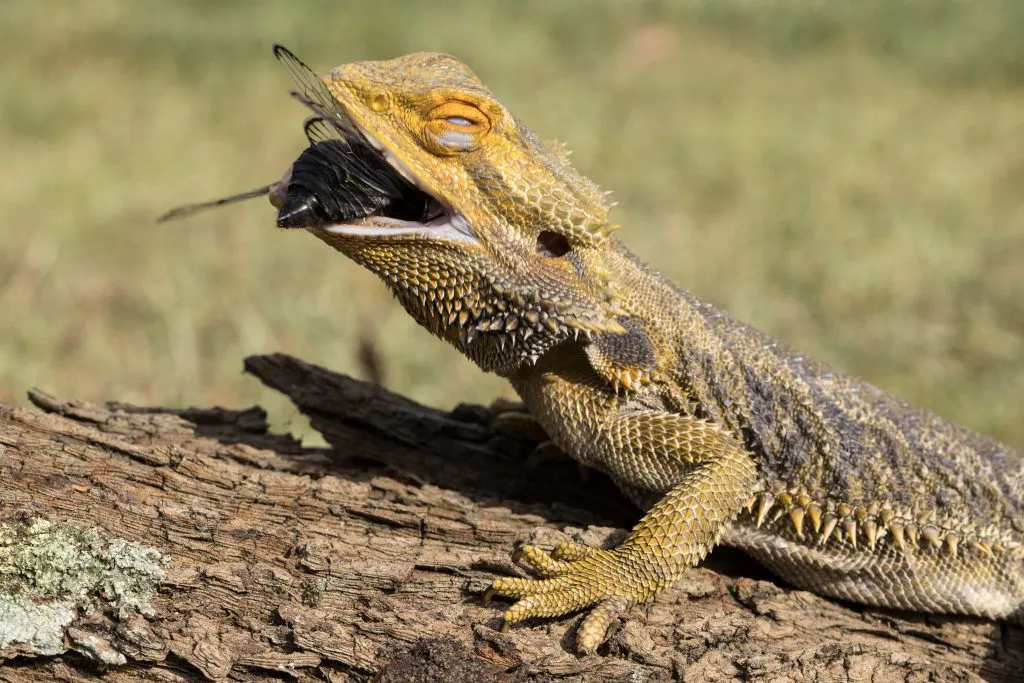
Instead of closing both eyes, your bearded dragon might just close one eye only. Now, what’s the reason behind this?
The most common answer is that bearded dragons close one of their eyes while focusing on something, like prey. For instance, they might do it when you offer live prey to them.
However, if your bearded dragon closes the same eye continually, you need to check further. This can be due to various reasons as listed below.
- Parasitic or eye infection in one eye
- Stuck shed near one eye
- Lighting issues
You need to take appropriate action depending on what is causing your beardie to keep one eye closed.
When to Take Your Bearded Dragon to a Vet?
If your bearded dragon is closing its eyes, there might be some concerning reasons that require a vet visit.
We recommend visiting a vet in the below-mentioned situations.
- Your beardie is exhibiting signs of illnesses like lack of appetite, lethargy, weight loss, irregular stool, and aggression.
- Presence of parasitic or eye infections
- In the cases of severe dehydration
- Any drastically abnormal behavior
Tip: If you don’t have a reptile vet near you or if you want to avoid unnecessary trips and costs, you can book an online vet here!
If your bearded dragon is simply closing its eyes when you’re holding or petting them, there’s not much need to visit a vet. You just need to build your pet’s trust. Similarly, if there’s an issue with the basking bulb, simply replace it.
How to Avoid Eye Problems in Bearded Dragons?
Eye problems due to nutrient deficiencies, eye infections, or parasitic infections can get serious and painful for your bearded dragons. As we stated earlier, the main causes are poor diet, bad hygiene, and improper
Let’s check out some ways to prevent eye problems in your dear beardie.
Tip 1: Keep the Enclosure Clean
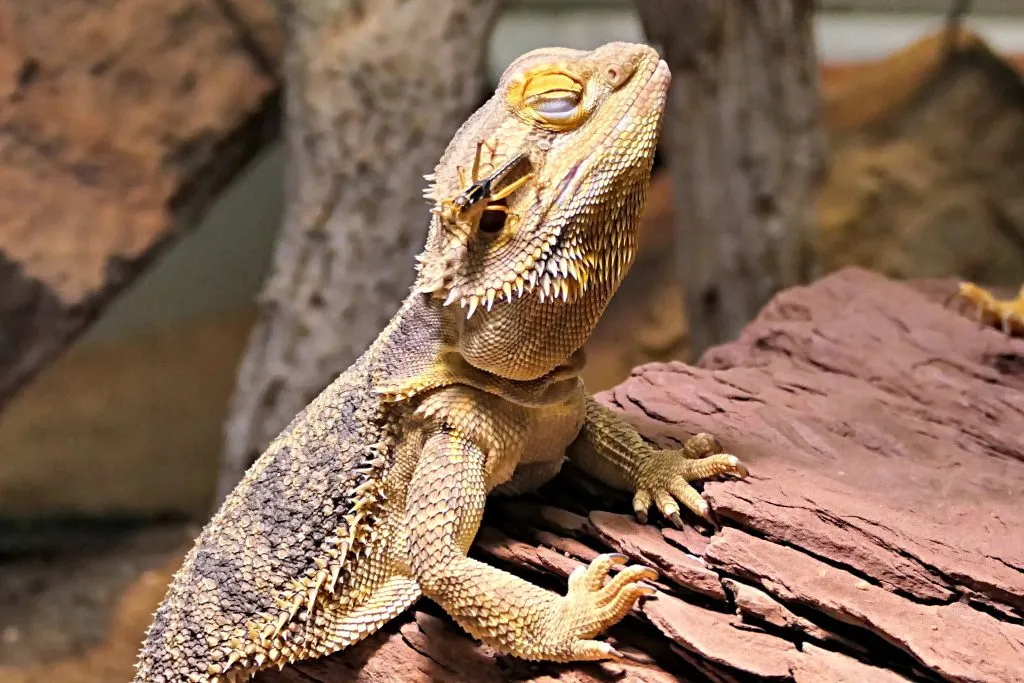
A dirty enclosure is the breeding ground for various bacteria and parasites. Therefore, you need to clean the
Here’s how you can clean your beardie’s
- Step 1: Empty the enclosure. Remove all the items inside, including
tank accessories, bowls, and substrates. - Step 2: Next, rinse the
tank accessories and bowls with hot soapy water. - Step 3: Then, scrub the whole
tank with hot soapy water. - Step 4: Finally, rinse the soapy water and disinfect the
tank and its accessories - Step 5: Once done, allow everything to dry properly.
Tip 2: Provide Proper Temperature, Lighting, and Humidity
Improper temperature and humidity can cause tons of issues, including eye problems. The table below states the proper temperature and humidity requirements for bearded dragons.
| Category | Bright End | Cooler End |
| Temperature | 100F – 107F | 71F – 79F |
| Humidity | 35% – 40% | 35% – 40% |
As we discussed above, you also need to provide UVB lighting (8% to 10%) to your bearded dragon for 12 to 14 hours.
Tip 3: Offer a Nutrient-Rich Diet
Bearded dragons need to have a nutrient-rich diet to avoid and resist eye problems.
You need to provide your beardie with a diet consisting of 80% plants and 20% insects. It’s also best to give Vitamin A-rich vegetables like carrots, lettuce, and kale.
In the case of dehydration, moisture-rich vegetables like cucumber, zucchini, and tomatoes can be fed occasionally.
Final Thoughts
Bearded dragons love to stay on the watch! So, it is highly unlikely for them to keep their eyes shut.
If you notice this behavior in your bearded dragon, do consider the reasons stated in this blog post and follow the possible solutions. However, if the issue persists, you should take your beardie to a vet immediately.
- Enchi Ball Python: A Unique and Stunning Morph of Python regius - March 27, 2025
- Emerald Tree Monitor: The Enigmatic Green Guardian of the Rainforest - March 26, 2025
- The Egyptian Cobra (Naja haje): A Fascinating Serpent - March 25, 2025
